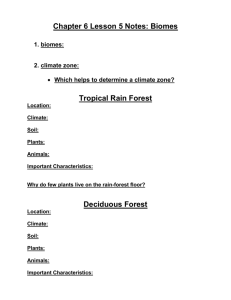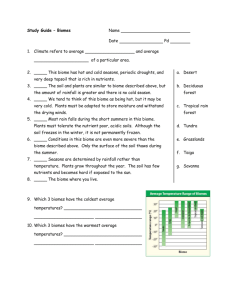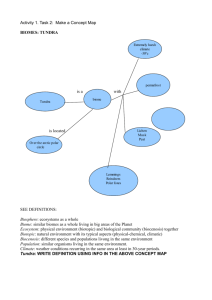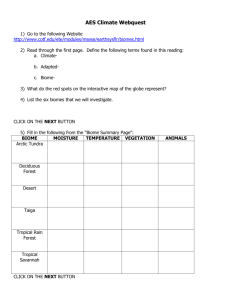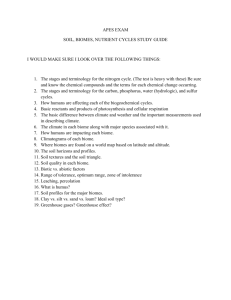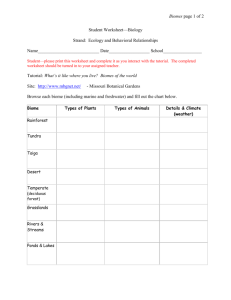Biomes
advertisement
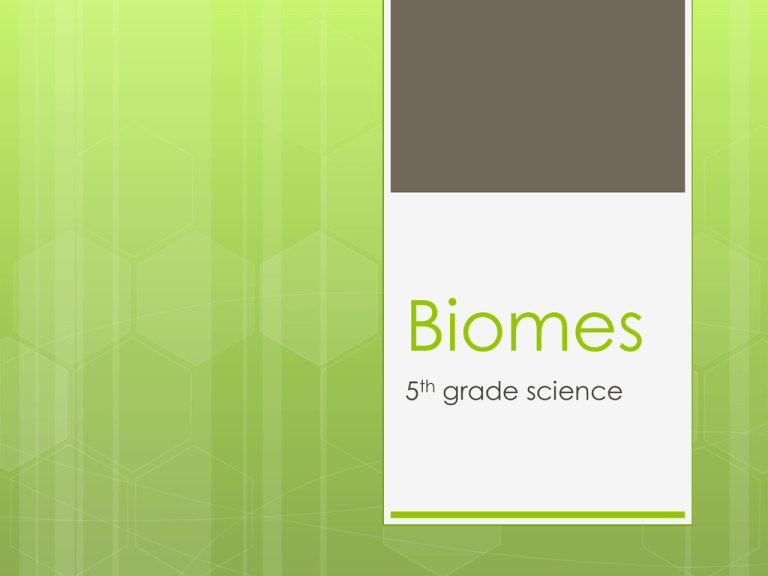
Biomes 5th grade science Essential question How can I use biotic and abiotic factors to compare biomes? How can classify biomes? How are living things organized? I can… I can understand that there are different biomes and how to differentiate between them. I can sort, classify and identify biomes based on biotic and abiotic factors. What is a Biome… Terrestrial Biomes Terra= land Taiga Tundra Grassland Desert Deciduous Forest Rainforest Aquatic Biomes Aqua= water Oceans Estuaries Lakes Ponds Mash lands Click the pic for video Smartboard sort! Location Mid latitudes Color biome map Climate and soil Mild summers and cold winters. 30-50 Only inches of precipitation per year location with 4 true seasons Plants/leaves Nutrient change colors rich top soil Plants Lichen, Why do leaves change colors? Brainpop video moss, ferns and wild flowers- daisies, day lilies Shrubs Hardwood trees: oaks, birch, hickory, maple. Animals Wolves, deer, bears, chipmunks, squirrels variety of amphibians and reptiles. Frogs, toads, snakes etc. Insects Deciduous forest Layers of the deciduous forest Optional activities Take a nature walk around the perimeter of the playground and record observations Make a biome in a bag: http://pbskids.org/zoom/activities /sci/biomeinabaggie.html Tropical Rainforest Near the equator Brainpop video on Rainforests Climate and soil Hot/warm all year round. 80-100 inches of precipitation per year Humid (amount of water vapor in air) Nutrient poor soil. Plants Greatest diversity of any biome Vines Orchids, ferns Wide variety of trees See some plants! http://www.blueplanetbiomes.org/rnfrs t_plant_page.htm Click picture for more! Animals More species of insects, reptiles and amphibians than anywhere else - Biodiversity Monkeys Many birds Some small mammals http://www.rainforestanimals.net/ If you have time click the picture for A video about rainforests! Rainforest activities Reasons for deforestation and problems caused: http://greenfieldgeography.wikispaces.com/IGC SE+and+GCSE+Weather,+Climate+and+Ecosyste ms (scroll down for chart) Make creature cards: http://teacher.scholastic.com/scholasticnews/inde pth/rainforest/lesson_helpers.asp Rainforest levels foldable: http://greenfieldgeography.wikispaces.com/IGC SE+and+GCSE+Weather,+Climate+and+Ecosyste ms (scroll down for picture and description) Grasslands Brainpop video about Grasslands: Savanna ---- Location Naturally occurring on all continents except Antarctica. Mid-latitudes and interiors of continents. Climate and soil Cool in the winters, hot in the summers 10-30 inches of precipitation per year Rich Flat topsoil open landscape Plants Mostly Some Wild grasses and small shrubs trees near sources of water herbs Flowering Short plants video on Grasslands! Animals American: prairie dogs, foxes, snakes, birds African: elephants, lions, zebras, giraffe. Cam at a bison watering hole: http://explore.org/live-cams/player/plainsbison-grasslands-national-park-cam-1 Africam: http://www.africam.com/wildlife/ Grasslands activities! Research the various types of grasslands across the world and record what you discover. http://www.blueplanetbiomes.org/savan na.htm http://www.blueplanetbiomes.org/steppe .htm http://www.blueplanetbiomes.org/prairie. htm Deserts Click the picture to view Brain pop video about deserts! Location Mid-latitudes All 7 continents have some form of desert Climate and Soil Generally very hot days, and cool nights Less than 10 inches of precipitation per year Soil is poor: from lack of decay but rich in minerals Plants Cacti Yuccas Bunch grasses Shrubs A few trees Animals Rodents, snakes, lizards, tortoises, insects, and some birds. Sahara in Africa: Camels, gazelles, antelopes, small foxes, snakes, lizards, and gerbils Desert Activities! Extra http://app.discoveryeducation.com/searc h?Ntt=desert+animal+adaptations The Time Video on deserts magic school bus-deserts http://app.discoveryeducation.com/searc h?Ntt=magic+school+bus+deserts Foldable about hot and cold deserts Use powerpoint Animal Adaptation Animals need to make many adaptations to adjust to living in the desert. The extremely high temperatures and little water make this important! http://app.discoveryeducation.com/searc h?Ntt=desert+animal+adaptations Taiga or Coniferous Forest Brainpop video Location Mid to high latitudes Between the Deciduous Forest and Tundra. Climate and Soil Very cold winters, and cool summers. About 20 inches of precipitation a year Soil is poor Covered with pine/needles on the surface Plants Mostly spruce, fir, and other evergreens aka conifer trees. Why evergreen? adaptation! Animals Rodents, snowshoe hares, lynx, caribou, wolves, and birds in the summer! Notice adaptations? Taiga Activities! Look at two animals in the taiga biome: Draw a picture List their name 1 fact about them Any adaptations Is it structural or behavioral Why do they need it/how does it help? Tundra Brainpop video Location High, northern latitudes 3 kinds: Arctic Tundra, Alpine Tundra, and Antarctic Tundra Climate and Soil Very cold, harsh, and long winters Short and cool summers 4-10 inches of precipitation per year Soil is poor permafrost layer Layer of permanently frozen soil. Plants Grasses, wildflowers, mosses, and small shrubs. No trees. Animals Musk oxen, migrating caribou, arctic foxes, weasels, snowshoe hares, owls, hawks
